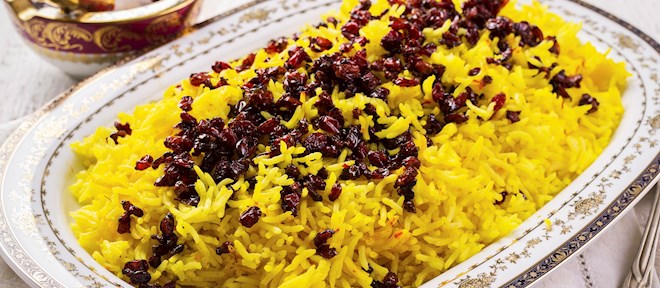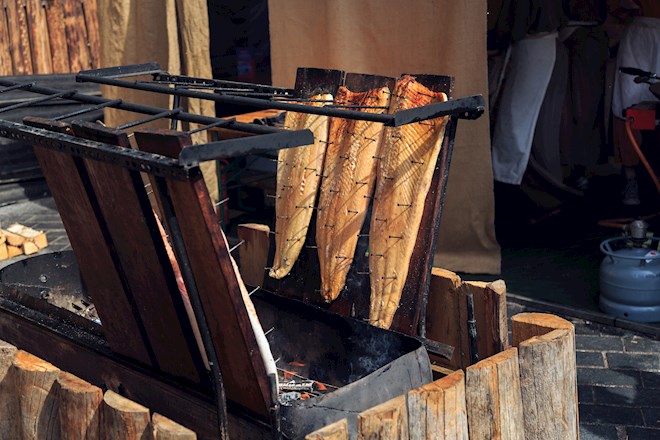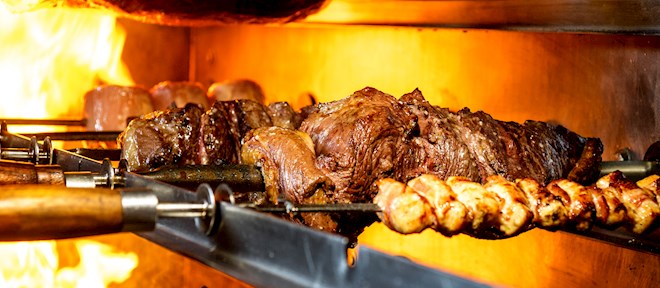Techniques
Techniques & producers

No results.
Try changing the search filters.Techniques

Kateh

Kateh is one of the easiest and simplest techniques for preparing and serving rice, preferably long-grained because it absorbs water better than most other types of rice. The rice is washed, drained, and cooked in lightly salted and oiled water. I... READ MORE
Churrasco
Churrasco is a Brazilian barbecue method where juicy pieces, slices, steaks, and chops of beef, veal, lamb, pork, and chicken are placed on big skewers and grilled over wood fire. It started in the early 1800s when the Gauchos (European immigrants... READ MORE
Asado
Considered an epitome of Argentinean gastronomy and culture, asado (lit. roast; roasted) is much more than merely a meal. In Argentina, Chile, Uruguay, Paraguay, and in a number of other South American countries, it is both a culinary and social e... READ MORE
Parrilla
Parrilla is an Argentine word with two meanings – it can be used to describe a typical Argentine steakhouse restaurant, or it can denote a metal grill used for preparing the meat and fish. The metal grill is a part of traditional asado barbe... READ MORE
Kushiyaki
Kushiyaki is a Japanese technique that includes various skewered and grilled meat, seafood, or even vegetables and tofu. The ingredients are placed on bamboo skewers and are typically seasoned with either salt (shio) or a reduced and sweetened ver... READ MORE
Shashlik
Shashlik is the name for a traditional Central and West Asian barbecue consisting of marinated, skewered, and grilled chunks of meat such as lamb, beef, or pork, depending on regional and religious preferences. Lamb, beef, or pork is usually combi... READ MORE
Siu mei
Siu mei refers to a style of Chinese cuisine that is primarily characterized by roasting meat on spits over an open fire or in a rotisserie oven. Originating from Guangdong province in southern China, this culinary tradition is p... READ MORE
Central Texas-Style Barbecue
Central Texas-style barbecue originated in the Czech and German meat markets in the late 19th century. This barbecue style is typically associated with cooking brisket (the fattier portion is called point, while the leaner portion is call... READ MORE
South Texas-Style Barbecue
South Texas-style barbecue is an American regional barbecue style in which it's all about barbacoa and cow heads – they are cooked in a pit lined with stones or bricks, and then a mesquite fire is started in the bottom of the pit. Agave leav... READ MORE
Leskovački roštilj
Leskovački roštilj refers to a traditional method of grilling meat which is considered the highest form of barbecue art in Serbia and beyond. Hailing from Leskovac, the technique, according to local belief, is thought to have been brought o... READ MORE
Antikristo
Antikristo is a traditional technique of cooking meat on Crete. A young lamb (or a goat, on rare occasions) is cut into four pieces (called goulidia), salted, then placed on big wooden skewers that are arranged around the fire in a circul... READ MORE
Karaage
Also known as dry-frying, karaage is a Japanese cooking technique in which various foods are first lightly coated in arrowroot starch, then deep-fried. The use of arrowroot starch preserves the natural water content of fried foods and pro... READ MORE
Barbacoa
Barbacoa is a term that is mostly associated with Mexico and refers to an ancient technique of cooking meat in underground ovens. There are numerous regional varieties, which usually differ in the type o... READ MORE
Hot pot
Hot pot is a traditional technique of preparing soup-like or stew-like dishes made with a variety of East Asian ingredients. The dish is prepared by simmering a pot of soup stock at the table, then placing the ingredients into the pot. Typical ing... READ MORE
Tataki
Tataki is the Japanese technique of preparing meat or fish, where the product is briefly seared and left raw in the middle. Most commonly, tuna steaks or beef tenderloin is employed in the tataki technique since perfect cuts allow equal searing on... READ MORE
Nabemono
Nabemono is the name encompassing numerous Japanese one-pot dishes, cooked with a variety of ingredients. In restaurants, they are usually prepared tableside and served to the guests. The name derives from the traditional pot in which the ingredie... READ MORE
Braai
Braai is a South African term for barbecue, and it can be both a noun and a verb – you can braai a sausage or a steak, but you can also throw a braai with friends. There is no real braai without the fire, and it isn't consi... READ MORE
Texas-style barbecue
Texas-style barbecue is an American barbecue style that can be divided into 4 separate subcategories: Central Texas, East Texas, South Texas, and West Texas barbecue.
The best-known variety is the Central Texas-style that originated in the... READ MORE
Mtsvadi
Mtsvadi is a traditional dish consisting of a skewered shish kebab. Pork, mutton, or veal is typically marinated in a mixture of lemon juice, pomegranate juice, tarragon, salt, pepper, and chopped onions, so that it remains tender and juicy when g... READ MORE
Memphis-Style Barbecue
Memphis is also known as the Pork Barbecue Capital of the World. This barbecue style usually employs pork ribs and shoulders, although some restaurants still use chicken or beef. Dry rub ribs are typically seasoned with paprika and salt, giving th... READ MORE
Khorovats
Khorovats is a unique Armenian barbecue method where the meat is first placed on a set of high-quality skewers called shish and shampoors, then grilled on mangal, a grill often shared among neighbors, or less commonly, b... READ MORE
West Texas-Style Barbecue
West Texas barbecue (a.k.a. cowboy-style) is a type of American regional barbecue style in which the meat is not smoked, but cooked directly over mesquite coals instead. Goat, mutton, chicken, and beef are the most typical types of meat u... READ MORE
Barbecue
Modern American barbecue stems directly from barbacoa, the tradition of smoke-cooking meat which Caribbean natives were doing long before the colonists arrived. Today, the centuries-old technique of smoking whole hogs over a pit is now co... READ MORE
Tandoori
The most popular Indian dishes are those cooked over a blazing fire in the so-called tandoor, a cylindrical open-top clay oven fueled by wood or charcoal. The tandoori technique evolved from an old Middle Eastern method of baking bread, w... READ MORE
Gratin
The French expression au gratin is an everyday term in the culinary world, denoting a technique for preparing oven-baked dishes. In the 16th century or even earlier, the word gratin referred to the burnt, crispy bits of a dish th... READ MORE
Teppanyaki
Teppanyaki is a Japanese technique of grilling a variety of ingredients on an iron plate. Its name is derived from two words: teppan or an iron plate, and yaki, meaning grilled or broiled. Teppanyaki re... READ MORE
Tikka
Indian tikka is a dish consisting of boneless meat, usually chicken, that is cut into smaller pieces and marinated in yogurt and traditional Indian spices such as turmeric, cumin, coriander, cayenne pepper, chili, garlic, and ginger. The ... READ MORE
Red-cooking (Hong shao)
Also known as red-braising, red-stewing or flavor-potting, red-cooking is a traditional slow-braising technique that uses soy sauce, rice wine, and caramelized sugar to flavor the food and give it a dark red color. Other key ingr... READ MORE
Chinese BBQ pork (Char siu)
Char siu is a dish consisting of roasted, barbecued pork that has previously been marinated in the eponymous sauce, including ingredients such as soy sauce, hoisin sauce, rice wine, and star anise. The pork is usually served either as a sliced app... READ MORE
Jamaican Jerk
In the past, jerk was used to refer to a pig that was slowly grilled over a fire of pimento wood. Today, the main ingredient is typically chicken, pork, or beef. Jerk refers to a unique Jamaican cooking method where pork, chicken, beef, s... READ MORE
Shuizhu
This traditional Sichuan technique translates as water-boiled. It employs thin slices of meat or fish that are shortly cooked in water or broth and are then placed on a bed of various vegetables such as onions, mushrooms, spinach, bean sp... READ MORE
Kansas City-Style Barbecue
Barbecued meat is the gastronomic passion of the so-called "world capital of barbecue", also known as Kansas City. Barbecued pork ribs, flavorful slices of hot or cold beef brisket, or a "pig salad" of succulent pulled pork - those are just some o... READ MORE
Ssam
Ssam is a South Korean technique that encompasses various dishes that are made by wrapping different ingredients in raw or blanched lettuce, other green leafy vegetables, as well as seaweed or other wrappers. The dishes are classified depending on... READ MORE
Sač
Peka or sać is an ancient technique of preparing various dishes inside the eponymous bell-shaped cooking vessel. The technique is mostly used for the preparation of meat, vegetables, or seafood that are seasoned and cooked together with o... READ MORE
Xinjiang lamb skewers
Xinjiang lamb skewers is a dish consisting of pieces of lamb (rarely even mutton) that are skewered onto a stick and then grilled using a special technique. The lamb is first cut up into pieces, each having a different texture and flavor. Every pi... READ MORE
North Carolina-Style Barbecue
North Carolina barbecue can be split into two halves – in the east, they use the whole hog, while in the west, also known as Lexington-style barbecue, smokes only the pork shoulder. Eastern barbecue is usually chopped with a vinegar... READ MORE
Gradele
Originating from the Croatian coast, gradele is a traditional way of grilling fresh fish over an open fire. Although fish is the most common option, meat and snails can also be prepared in the same way. The word gradele refers to a simple... READ MORE
St. Louis-Style Barbecue
St. Louis-style barbecue uses spare ribs that are grilled (instead of being slow-smoked) and heavily sauced with a sweet, acidic, and sticky tomato-based barbecue sauce that is typically made without liquid smoke. The ribs are cut in a special way... READ MORE
East Texas-Style Barbecue
East Texas-style barbecue is an American barbecue style characterized by the acceptance of pork (along with the ever-popular Texas beef) and an emphasis on barbecue sauce. Pork ribs and smoked boudin are staples of East Texas-style barbecue, typic... READ MORE
Teriyaki
Teriyaki is a Japanese cooking technique in which the ingredients are broiled, roasted, or grilled after they have been marinated in teriyaki sauce, consisting of soy sauce, mirin, and sugar. The word teriyaki is a combination of two word... READ MORE
Tempura
Although tempura is battered and deep-fried, the Japanese approach to food, characterized by clean flavors, simplicity, and minimalistic approach to ingredients remains intact. The most favorable ingredients for the dish include shrimp, scallops, ... READ MORE
Lists
- Top 38Asian Techniques
- Top 100Techniques in the World
- 19 Worst RatedTechniques in the World
- Top 29European Techniques
- Top 28Techniques in East Asia
- Top 18North American Techniques
- Top 18Japanese Techniques
- Top 15South American Techniques
- Top 15Western European Techniques
- Top 15American Techniques
- Top 11Southern American Techniques
- Top 9Argentinian Techniques








